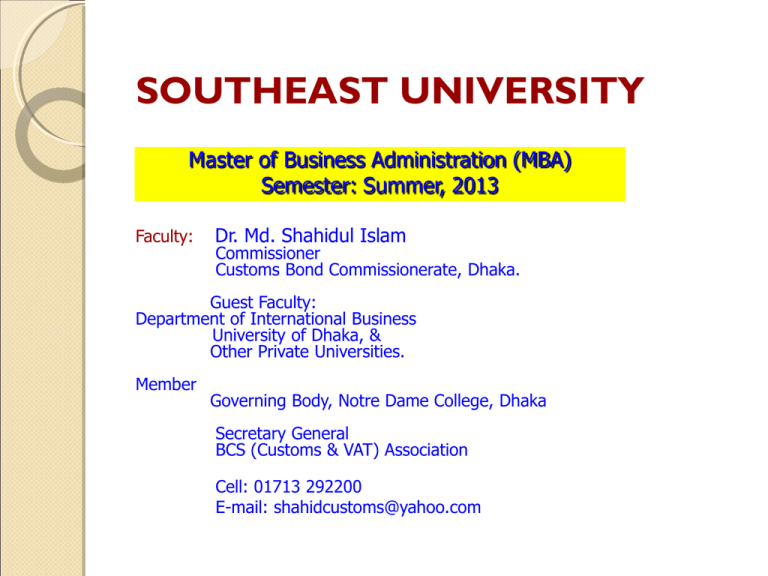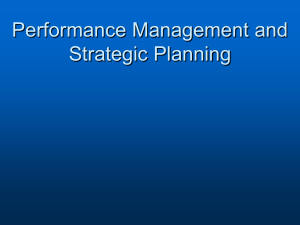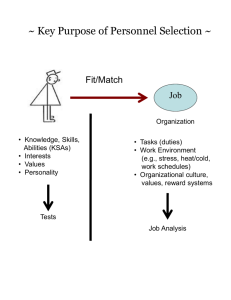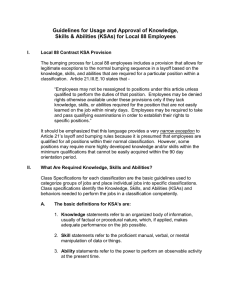HRM-Training & Devlop
advertisement

SOUTHEAST UNIVERSITY Master of Business Administration (MBA) Semester: Summer, 2013 Faculty: Dr. Md. Shahidul Islam Commissioner Customs Bond Commissionerate, Dhaka. Guest Faculty: Department of International Business University of Dhaka, & Other Private Universities. Member Governing Body, Notre Dame College, Dhaka Secretary General BCS (Customs & VAT) Association Cell: 01713 292200 E-mail: shahidcustoms@yahoo.com Course Title : Training and Development Course Code : HRM 6184 Total Marks : 100 Marks Distribution: Attendance :05 Class Test :10 Assignment :15 Mid Term :30 Term Final :40 Class Test (CT): Assignment: Mid Term: Final: Best 2 consider out of 3 CT (I) Term Paper -7.5 (II) Presentation -7.5 Should have attain 3 Questions out of 4 Should have attain 4 Questions out of 6 Reference Books: 1. Effective Training –P. Nick Blanchard - James W.Thacker - V. Anand Ram 2. Employee Training and Development -Raymond A. Noe What will be covered in Training and Development Training on Organizations Aligning Training with Strategy Learning, Motivation, and Performance Needs Analysis Training Design Traditional Training Methods Computer-Based Training Methods Development and Implementation of Training Evaluation of Training Key Areas of Organizational Training Employee and Management Development What will be covered in Training and Development Training on Organizations Aligning Training with Strategy Learning, Motivation, and Performance Needs Analysis Training Design Traditional Training Methods Computer-Based Training Methods Development and Implementation of Training Evaluation of Training Key Areas of Organizational Training Employee and Management Development Preferred Reference Book Chapter-One Training on Organizations Training System and Process Training provides employees with the knowledge and skills to perform more effectively. This allows them to meet current job requirements or prepares them to meet the inevitable changes that occur in their jobs. However, training is only an opportunity for learning. What is learned depends on many factors, such as the design and organization’s learning climate. Training is also part of an integrated system in which performance is measured against criteria (best practices benchmarks) that are tide to strategic objectives. Training is used extensively to help employees understand how they can assist in meeting corporate objectives. Effective training requires more than just having key managers available. It requires that effective systems are in place to address the performance issues facing the organization. With the in mind, we turn to the design of an effective trainings system. Training on Organizations Training as an Open System Open systems have a dynamic relationship with their environment, closed systems do not. Obviously, a business must interact with its environment, making it an open system. An open system depends on the environment for the input that supports the system. A business, for example, needs raw materials, capital, and employees in order to operate. The environmental inputs are transformed into outputs by the system’s processes. For a business, these would include its products and service. The system’s outputs flow into the environment and might or might not influence future inputs into the system. In effective systems, the system output influences the environment to supply new supportive input to the system. Many open systems exist as part of another open system and, therefore, are called subsystems. The organization’s mission, strategies, resources, and the like, all represent sources of input into the training subsystem. Of course, if the training department is part of a larger HR function, then these inputs would be filtered through that system. Organizational and employee needs, training budgets, staff, equipment, and so forth, are all inputs from the organization to the training subsystem. Training on Organizations Training as an Open System/Cont.... Training processes transform these inputs into usable output for the organization (improved knowledge, skills, and attitudes, job performance, and so on). Looking at the training unit from an open system perspective shows how interconnected training activities are with what is happening elsewhere in the organization. The point here is that the organization inverts money in the training function, for which it expects a favorable return. Periodically, the organization will examine the returns from training and determine whether the training. Open System Input Process Output System’s External Environment General open systems model Training on Organizations Training’s Organizational Environment Mission Strategy Structure Policies Procedures Finances Resources People Products Technology Training Subsystem Input Process Organization Needs Employee Needs Budget Equipment Staff Analysis Design Development Implementation Evaluating Output Ennobled Skills Attitudes Motivation Job Performance Training as a Subsystem Within The Organization Training on Organizations The Training Process Model Analysis Phase: The analysis phase begins with the identification of the organizational performance gap Actual Organizational Performance (AOP) is less than Expected Organizational Performance (EOP). Things such as profitability shortfalls, low levels of customer satisfaction, or excessive scrap are all examples of a current performance gap. Another type of performance gap is future oriented. Here, the company is seen as likely to perform poorly in the future unless changes are made. The analysis phase is often referred to as a training needs analysis (TNA). However, both training and non-training needs are identified with this process. The cause of the performance gap might be inadequate knowledge, skills, or attitudes (KSAs) of employees. If so, then training is a possible solution. However, KSA deficiencies are only one of many reasons for performance gaps. Other reasons for performance gaps, such as motivation issues or faulty equipment, must be separated from KSA deficiencies, as these are nontraining needs and require a different solution. In the analysis phase, the cause of the performance gap is identified, separating KSA from non-KSA causes. Those performance gaps caused by KSA deficiencies are identified as “training needs” because training is a solution. All other causes are defined as non-training needs. The analysis phase also attaches priorities to the training needs that are identified. Not all needs will have the same level of importance for the company. This process of data gathering and causal analysis to determine which performance problems should be addressed by training is the analysis phase of the analysis phase of the training process. Training on Organizations Needs Analysis Phase Input Process Output Design Phase Input Process Output Development Phase Triggering Event Input Process Output Implementation Phase Input Process Output Process Evaluation Data Evaluation Phase Outcome Evaluation Data Input Process Training Processes Model Output Training on Organizations The Training Process Model/Cont.... Design Phase: The Training needs identified in the analysis phase, in addition to areas of constraint and support, are the inputs to the design phase. An important process of the design phase is the creation of training objectives. these provide specific direction for what will be trained and how. Development Phase: Development is the process of formulation an instructional strategy in meet a set of training objectives as well as obtaining or creating all the things that are needed to implement the training program. Implemented Phase: All the aspects of the training program come together during the implementation phase; however, it is a mistake to assume that everything will happen as planned. Therefore,, it is useful to conduct a dry run and even a pilot of the program. Evaluation Phase: Although we discuss the phase of the model last, it actually begins during the development phase. Recall that evaluation objectives are an output of the design phase. These outputs become to the evaluation phase. First process evaluation determines how well a particular process achieved its objectives (i.e. outputs) Outcome evaluation is the conducted at the end of the training to determine the effects of training on the trainee, the job, and the organization Training on Organizations Trends in Training This business environment will continue to change rapidly. These changes bring both challenges and opportunities. Successful companies in most industries must constantly realign their activities to meet new conditions while remaining true to their mission and strategic direction. As companies adapt, their trailing function also needs to adapt. Multiple surveys over the last several years have asked HR executives and human resource development (HRD) mangers to. Identify their organization’s needs for the next several years. What are the trends in training for the near future? Aligning training with business strategy Managing talent due to changing demographics Improving the training function Quality Legal issue Each of the above issue is discussed below in terms of the opportunities and challenges it presents to the training function. Training on Organizations Aligning Training with business strategy Diversity: Increased diversity brings both the opportunity for new ways of approaching business issues and the challenges of finding ways to integrative these doddering perspectives. Along with more diversity in terms of gender, ethnicity, and so forth, the workforce is becoming more diverse with respect to age. Four distinct generations are currently in the workforce. Each generation has a different set of values relation to the role of work in their like. Knowledge Workers: In the twenty-first century, a company’s most valuable assets will be “knowledge workers (KWs)”-a term Drucker coined to indicate the criticality of knowledge and skills of its workforce for a company. With knowledge workers switching jobs frequently, one of the major concerns of organization is to tap the knowledge available with each employee before he leaves the organization. Developing the Right Talent: The worldwide economic recession that began in 2008 has certainly eliminated that concern, at least in the near term. Nonetheless, it is now and will continue to be important for most business to secure workers with the right skill sets. Is many organizations, you will find the training function focusing on the following types of initiatives. Training on Organizations Developing the Right Talent/Cont.. In many organizations, you will find the training function focusing on the following types of initiatives: Programs that focus on the recruiting and selection process. Programs that improver retention of knowledge workers. Programs that access and track job requirements and employee competencies. Development of innovative knowledge delivery system. Training on Organizations Quality and Continuous Improvement.: Training must be seen as an integral part of the organization’s performance improvement system. The International Organization for Standardization (ISO), located in Geneva, Switzerland, developed a set of worldwide standards to ensure consistency in product quality by all companies that become certified. In general, there five stages in the certification process. 1. Pre-audit 2. Process mapping 3. Change 4. Training 5. Post-Audit In addition to improve training process, companies with ISO certification also find the following advantages: o Improved Efficiency o Higher Productivity o Better internal communication o Improves quality image and market competitiveness. o Increased customer preference. o Increase awareness of opportunities for process and quality improvements. o Reduced cost and improved ability to document quality control process to their customers. Training on Organizations Legal Issue: Equal employment opportunity, affirmative action, sexual harassment, and related legislation have placed legal requirement of business regarding specific types of training. You will learn in detail the training issue related to sexual harassment and equity (specifically related to females in nontraditional jobs, the glass ceiling, and the disabled) in Chaptr10. In addition, trainers need to be aware of liability issues, copyright infringement, and other legal concerns. The discussion of these issues in not intended to provide technical legal information, but rather to provide a general (and understandable) description of the important legal issues related to training activities. Equity: In North America, federal, state, or provincial law and associated court rulings provide the complex legal framework within which business must develop their HR policies and practices. Even though legislation initially focused on the selection of people into the organization, there are many areas related to training that also require attention, For employees with disabilities (physical or mental). The employer must not only assure equal opportunity for training, but also make reasonable accommodation. Reasonable accommodation means making training facilities and materials readily accessible and useable to those with a disability. Depending on the disability, this could include instructional media and/or providing readers. Training on Organizations Required Training: Some training is required by law. Failure to provide this training will subject the company to sanction from the courts or federal and strata regulation. Liability for injury of illness: Some types of training programs have the potential to cause physical or psychological injury or illness to participants. Confidentiality: An employee’s performance during and at the conclusion of training is confidential in the same manner as other employee information. Thus, if performance in training is to be used in promotion or salary decisions, the employee must be informed that it will be used in that. Unless permission has been granted, or the trainee is informed prior to training the such discussion would occur, trainers must also avoid discussion of the trainee’s performance with other employees. Copyrighted Materials: The use of nay copyrighted material without permission of the owner is illegal. If your training vendors infringe on the copyrighted material of others while providing your company with services, your company could with services, your company could be liable for damages. Thus, as the training manger, you would want to make sure that your contract with the vendor required the legal use of any copyrighted materials. Training on Organizations Career Opportunities in Training: The person in charge of customer service training, for example, would work with specialists in these areas to do the following. Determine the customer service training needs in the organization. Develop training programs to meet those needs. Develop materials to the instructional methods to be used in the programs. Evaluate the effectiveness of the programs. Learning: Definition for learning found in literature very according to the theoretical background of the authors. Unless otherwise indicated, the term learning in this text means a relatively permanent change cognition (i.e., understanding and thinking) that results from experience and that directly influences behavior. This definition, of course, reflects our own theoretical assumptions. We will discuss this definition and others at length in Chapter 3. Training on Organizations Knowledge Skills, and Attitudes Knowledge: Knowledge is an organized body of facts, principles, procedures, and information acquired over time. thus, learning refers to: The information we acquire an place into memory (declarative); How information is organized for use, into what we already know (procedural); and Our understanding of how, when, and why information is used an is useful (strategic). Declarative Knowledge: Declarative Knowledge is a person’s store of factual information about a subject Facts are verifiable blocks of information such as the legal requirement for hiring, safety rules, and the like. Evidence of factual learning exists when the learner can recall or recognize specific, blocks of information. Procedural knowledge: At a higher level is the person’s understanding about how and when to apply the facts that have been learned. This is referred to as procedural knowledge. It assumes some degree of factual knowledge, because some information must be known about and object or activity before rules for its use can be developed. Training on Organizations Knowledge Skills, and Attitudes/Cont... Strategic knowledge: The highest level of knowledge is strategic knowledge. This is used for planning, monitoring, and revision goal-directed activity. It required acquisition of the two lower levels of knowledge (facts and procedures). Strategic knowledge consists of a person’s awareness of what he knows and the internal rules he has learned for accessing the relevant facts and procedures to be applied toward achieving some goal. When this type ok knowledge is the focus of training reeducation, it is often called a “learning how to learn” program. Skills: A skill is a proficiency at being able to do something rather than just knowing how to do it. By skills, we mean the capacities needed to perform a person’s skill level is demonstrated by how well he is able to carry out specific actions, such as operation a piece of equipment, communicating effectively, or implementing a business strategy. There are two levels of skill acquisition: compilation (lower level) and automaticity (higher level). These reflect differences in the degree to which a skill has become routine or automatic. When person is learning a particular skill or has only recently learned it, he is in the compilation stage. Here he needs to think about what he is doing while performing the skill. After a person has mastered the skill and used it often, she has reached the atomicity stage. Training on Organizations Knowledge Skills, and Attitudes/Cont.. Attitudes: Employee beliefs and opinions that support or inhibit behavior.21 IN a training context, you are concerned about employees, attitudes in relation to their learning the training material and their job performance. Attitudes are important to training because they affect motivation. Motivation is reflected in the goals people choose to pursue and the effort they use in achieving those goals. Goals and effort are influenced by how a person feels about thing related to the goal (i.e.,) Because a person’s attitude influences behavior, attitudes that motivate employed to perform or learn more effectively need to be addressed through training. Competencies: A competency is a set of KSAs that enables a person to be successful at a number of similar tasks. In the broadest sense, job is broken down into a set of tasks, and the competencies required to perform the job are determined through an analysis of the tasks. A competency is more than just KSAs, it is the ability to integrate and use the KSAs to perform a tasks successfully. Training on Organizations Training, Development, and Education The terms training, development, and educational are used in different ways by various authors. Here, the terms training and development refer to distinct, but related, aspects of learning. Training is a set of activities, whereas development is the desired outcome of those activities. Training is the systematic process of providing an opportunity to learn KSAs for current or future jobs; Development refers to the learning of KSAs. In other words, training provides the opportunity for learning, and development is the result of learning, “training developments” are now called Human Resource Development departments, and “management training” is called management development. These changes in terminology reflect the change from a focus on the process (training) to a focus on the outcome (development). Education is typical differentiated from training and development by the types of KSAs development, which are more general in nature. While raining is typically focused on job-specific KSAs, education focuses on more general KSAs related, but not specifically tailored, to person’s career or job Training on Organizations Focus on Small Business Most business texts, especially those covering human resource management (HRM), focus on medium- to large-sized business for a number of reasons, including the following: Research typically requires a larger sample size. Larger firms have the budgets to support research. Policies and procedures are more formalized, thus easier to track. Techniques described HR texts usually require a formal HR function containing multiple areas of specialization, such as compensation, HRD selection, and so no.









